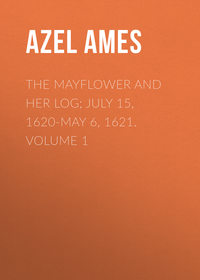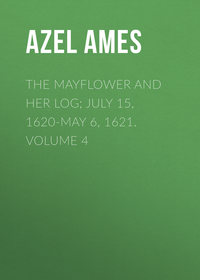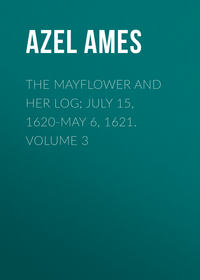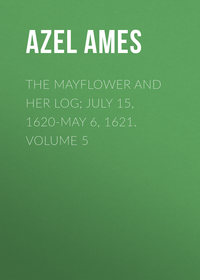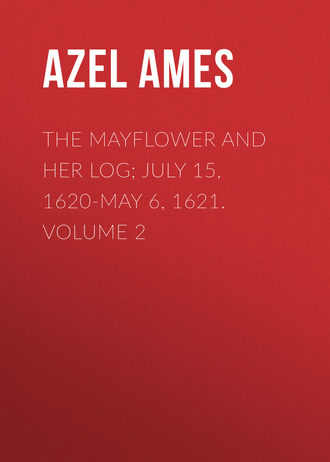 полная версия
полная версияThe Mayflower and Her Log; July 15, 1620-May 6, 1621. Volume 2
While it was feasible, when lying quietly at anchor in a land-locked harbor, with abundance of fire-wood at hand, to have a fire, about which they could gather, even if only upon the "sand-hearth" of the early navigators, when upon boisterous seas, in mid-ocean, "lying . . . in their cabins" was the only means of keeping warm possible to voyagers. In "Good Newes from New England," we find the lines:—
"Close cabins being now prepared,With bred, bief, beire, and fish,The passengers prepare themselves,That they might have their wish."Her magazine, carpenter's and sailmaker's lockers, etc., were doubtless well forward under her forecastle, easily accessible from the spar-deck, as was common to merchant vessels of her class and size. Dr. Young, in his "Chronicles of the Pilgrim Fathers" (p. 86, note), says: "This vessel was less than the average size of the fishing-smacks that go to the Grand Banks. This seems a frail bark in which to cross a stormy ocean of three thousand miles in extent. Yet it should be remembered that two of the ships of Columbus on his first daring and perilous voyage of discovery, were light vessels, without decks, little superior to the small craft that ply on our rivers and along our coasts . . . . Frobisher's fleet consisted of two barks of twenty-five tons each and a pinnace of ten tons, when he sailed in 1576 to discover a north-west passage to the Indies. Sir Francis Drake, too, embarked on his voyage for circumnavigating the globe, in 1577, with five vessels, of which the largest was of one hundred, and the smallest fifteen tons. The bark in which Sir Humphrey Gilbert perished was of ten tons only." The LITTLE JAMES, which the Company sent to Plymouth in July, 1623, was "a pinnace of only forty-four tons," and in a vessel of fifty tons (the SPEEDWELL), Martin Pring, in 1603, coasted along the shores of New England. Goodwin says: "In 1587 there were not in all England's fleet more than five merchant vessels exceeding two hundred tons." The SPARROW-HAWK wrecked on Cape Cod in 1626 was only 40 feet "over all." The Dutch seem to have built larger vessels. Winthrop records that as they came down the Channel, on their way to New England (1630), they passed the wreck of "a great Dutch merchantman of a thousand tons."
The MAY-FLOWER'S galley, with its primitive conditions for cooking, existed rather as a place for the preparation of food and the keeping of utensils, than for the use of fire. The arrangements for the latter were exceedingly crude, and were limited to the open "hearth-box" filled with sand, the chief cooking appliance being the tripod-kettle of the early navigators: This might indeed be set up in any part of the ship where the "sand-hearth" could also go, and the smoke be cared for. It not infrequently found space in the fore castle, between decks, and, when fine weather prevailed, upon the open deck, as in the open caravels of Columbus, a hundred years before. The bake-kettle and the frying-pan held only less important places than the kettle for boiling. It must have been rather a burst of the imagination that led Mrs. Austin, in "Standish of Standish," to make Peter Browne remind poor half-frozen Goodman—whom he is urging to make an effort to reach home, when they had been lost, but had got in sight of the MAY-FLOWER In the harbor—of "the good fires aboard of her." Moreover, on January 22, when Goodman was lost, the company had occupied their "common-house" on shore. Her ordnance doubtless comprised several heavy guns (as such were then reckoned), mounted on the spar-deck amid ships, with lighter guns astern and on. the rail, and a piece of longer range and larger calibre upon the forecastle. Such was the general disposal of ordnance upon merchant vessels of her size in that day, when an armament was a 'sine qua non'. Governor Winslow in his "Hypocrisie Unmasked," 1646 (p. 91), says, in writing of the departure of the Pilgrims from Delfshaven, upon the SPEEDWELL: "The wind being fair we gave them a volley of small shot and three pieces of ordnance," by which it seems that the SPEEDWELL, of only sixty tons, mounted at least "three pieces of ordnance" as, from the form of expression, there seem to have been "three pieces," rather than three discharges of the same piece.
The inference is warranted that the MAY-FLOWER, being three times as large, would carry a considerably heavier and proportionate armament. The LADY ARBELLA, Winthrop's ship, a vessel of 350 tons, carried "twenty- eight pieces of ordnance;" but as "Admiral" of the fleet, at a time when there was a state of war with others, and much piracy, she would presumably mount more than a proportionate weight of metal, especially as she convoyed smaller and lightly armed vessels, and carried much value. There is no reason to suppose that the MAY-FLOWER, in her excessively crowded condition, mounted more than eight or ten guns, and these chiefly of small calibre. Her boats included her "long-boat," with which the experience of her company in "Cape Cod harbor" have made us familiar, and perhaps other smaller boats,—besides the Master's "skiff" or "gig," of whose existence and necessity there are numerous proofs. "Monday the 27," Bradford and Winslow state, "it proved rough weather and cross winds, so as we were constrained, some in the shallop and others in the long-boat," etc. Bradford states, in regard to the repeated springings- a-leak of the SPEEDWELL: "So the Master of the bigger ship, called Master Jones, being consulted with;" and again, "The Master of the small ship complained his ship was so leaky . . . so they [Masters Jones and Reynolds] came to consultation, again," etc. It is evident that Jones was obliged to visit the SPEEDWELL to inspect her and to consult with the leaders, who were aboard her. For this purpose, as for others, a smaller boat than the "long-boat" would often serve, while the number of passengers and crew aboard would seem to demand still other boats. Winthrop notices that their Captain (Melborne) frequently "had his skiff heaved out," in the course of their voyage. The Master's small boat, called the "skiff" or "gig," was, no doubt, stowed (lashed) in the waist of the ship, while the "long-boat" was probably lashed on deck forward, being hoisted out and in, as the practice of those days was, by "whips," from the yardarms. It was early the habit to keep certain of the live- stock, poultry, rabbits, etc., in the unused boats upon deck, and it is possible that in the crowded state of the MAY-FLOWER this custom was followed. Bradford remarks that their "goods or common store . . . were long in unlading [at New Plimoth] for want of boats." It seems hardly possible that the Admiralty authorities,—though navigation laws were then few, crude, and poorly enforced,—or that the Adventurers and Pilgrim chiefs themselves, would permit a ship carrying some 130 souls to cross the Atlantic in the stormy season, without a reasonable boat provision. The capacity of the "long-boat" we know to have been about twenty persons, as nearly that number is shown by Bradford and Winslow to have gone in her on the early expeditions from the ship, at Cape Cod. She would therefore accommodate only about one sixth of the ship's company. As the "gig" would carry only five or six persons,—while the shallop was stowed between decks and could be of no service in case of need upon the voyage,—the inference is warranted that other boats were carried, which fail of specific mention, or that she was wofully lacking. The want of boats for unlading, mentioned by Bradford, suggests the possibility that some of the ship's quota may have been lost or destroyed on her boisterous voyage, though no such event appears of record, or is suggested by any one. In the event of wreck, the Pilgrims must have trusted, like the Apostle Paul and his associates when cast away on the island of Melita, to get to shore, "some on boards and some on broken pieces of the ship." Her steering-gear, rigging, and the mechanism for "getting her anchors," "slinging," "squaring," and "cockbilling" her yards; for "making" and "shortening" sail; "heaving out" her boats and "handling" her cargo, were of course all of the crude and simple patterns and construction of the time, usually so well illustrating the ancient axiom in physics, that "what is lost [spent] in power is gained in time."
The compass-box and hanging-compass, invented by the English cleric, William Barlow, but twelve years before the Pilgrim voyage, was almost the only nautical appliance possessed by Captain Jones, of the MAY- FLOWER, in which no radical improvement has since been made. Few charts of much value—especially of western waters—had yet been drafted, but the rough maps and diagrams of Cabot, Smith, Gosnold, Pring, Champlain and Dermer, Jones was too good a navigator not to have had. In speaking of the landing at Cape Cod, the expression is used by Bradford in "Mourt's Relation," "We went round all points of the compass," proving that already the mariner's compass had become familiar to the speech even of those not using it professionally.
That the ship was "well-found" in anchors (with solid stocks), hemp cables, "spare" spars, "boat-tackling" and the heavy "hoisting-gear" of those days, we have the evidence of recorded use. "The MAY-FLOWER," writes Captain Collins, would have had a hemp cable about 9 inches in circumference. Her anchors would probably weigh as follows: sheet anchor (or best bower) 500 to 600 lbs.; stream anchor 350 to 400 lbs.; the spare anchors same as the stream anchor.
"Charnock's Illustrations" show that the anchors used in the MAY-FLOWER period were shaped very much like the so called Cape Ann anchor now made for our deep-sea fishing vessels. They had the conventional shaped flukes, with broad pointed palms, and a long shank, the upper end passing through a wooden stock. [Tory shows in his diagrams some of the anchors of that period with the space between the shank and flukes nearly filled up in the lower part with metal.] Such an anchor has the maximum of holding powers, and bearing in mind the elasticity of the hemp cables then used, would enable a vessel to ride safely even when exposed to heavy winds and a racing sea: There is no doubt, according to the British Admiralty Office,—which should be authority upon the matter,– that the flag under which the MAY-FLOWER, and all other vessels of the merchant marine of Great Britain, sailed, at the time she left England (as noted concerning the SPEEDWELL), was what became known as the "Union Jack," as decreed by James the First, in 1606, supplanting the English ensign, which had been the red cross of St. George upon a white field. The new flag resulted from the "union" of the crowns and kingdoms of England and Scotland, upon the accession of James VI. of Scotland to the English throne, as James I. of England, upon the death of queen Elizabeth. Its design was formed by superimposing the red cross of St. George upon the white cross of St. Andrew, on a dark blue field; in other words, by imposing the cross of St. George, taken from the English ensign, upon the Scotch flag, and creating there by the new flag of Great Britain.
In a little monograph on "The British Flag—Its Origin and History," a paper read by its author, Jona. F. Morris, Esq., before the Connecticut Historical Society, June 7, 1881, and reprinted at Hartford (1889), Mr. Morris, who has made much study of the matter, states (p. 4): "In 1603, James VI. of Scotland was crowned James I. of England. The Scots, in their pride that they had given a king to England, soon began to contend that the cross of St. Andrew should take precedence of the cross of St. George, that ships bearing the flag of the latter should salute that of St. Andrew. To allay the contention, the King, on the 12th of April, 1606, ordered that all subjects of Great Britain travelling by sea shall bear at the maintop the red cross of St. George and the white cross, commonly called the cross of St. Andrew, joined together according to a form made by his heralds besides this all vessels belonging to South Britain or England might wear the cross of St. George at the peak or fore, as they were wont, and all vessels belonging to North Britain or Scotland might wear the cross of St. Andrew at the fore top, as they had been accustomed; and all vessels were for bidden to wear any other flag at their peril. The new flag thus designed by the heralds and proclaimed by this order was called the 'King's Colors.' For a long period the red cross had been the colors of English navigators, as well as the badge of English soldiery . . . . No permanent English settlement in America was made until after the adoption of the 'King's Colors.' Jamestown, Plymouth, Salem, and Boston were settled under the new flag, though the ships bringing over settlers, being English vessels, also carried the red cross as permitted." Mr. Barlow Cumberland, of Toronto, Canada, has also given, in a little monograph entitled "The Union Jack" (published by William Briggs of that city, 1898), an admirable account of the history of the British jack, which confirms the foregoing conclusions. The early English jack was later restored. Such, roughly sketched, was the Pilgrim ship, the renowned MAY-FLOWER, as, drafted from the meagre but fairly trustworthy and suggestive data available, she appears to us of to-day.
HER HISTORY:
In even the little we know of the later history of the ship, one cannot always be quite sure of her identity in the records of vessels of her name, of which there have been many. Dr. Nathaniel B. Shurtleff, of Boston, says that "a vessel bearing this name was owned in England about fifteen years or more before the voyage of our forefathers, but it would be impossible to prove or disprove its identity with the renowned MAY- FLOWER, however great such a probability might be. It is known, nevertheless, that—the identical famous vessel afterwards hailed from various English ports, such as London, Yarmouth, and Southampton, and that it was much used in transporting immigrants to this country. What eventually became of it and what was the end of its career, are equally unknown to history." Goodwin says: "It does not appear that the MAY- FLOWER ever revisited Plymouth, but in 1629 she came to Salem," with a company of the Leyden people for Plymouth, under command of Captain William Peirce, the warm friend of the Pilgrims, and in 1630 was one of the large fleet that attended John Winthrop, under a different master, discharging her passengers at Charlestown. Nothing is certainly known of her after that time. In 1648 a ship [hereinafter mentioned by Hunter] named the MAY-FLOWER was engaged in the slave trade, and the ill-informed as well as the ill-disposed have sometimes sneeringly alleged that this was our historic ship; but it is ascertained that the slaver was a vessel of three hundred and fifty tons,—nearly twice the size of our ship of happy memory. In 1588 the officials of Lynn (England) offered the "MAY- FLOWER" (150 tons) to join the fleet against the dreaded Spanish Armada. In 1657, Samuel Vassall, of London, complained that the government had twice impressed his ship, MAY-FLOWER, which he had "fitted out with sixty men, for the Straits." Rev. Joseph Hunter, author of "The Founders of New Plymouth," one of the most eminent antiquarians in England, and an indefatigable student of Pilgrim history among British archives, says: "I have not observed the name of MAY FLOWER [in which style he always writes it] before the year 1583 . . . . But the name soon became exceedingly popular among those to whom belonged the giving of the names to vessels in the merchant-service. Before the close of that century [the sixteenth] we have a MAY-FLOWER of Hastings; a MAY-FLOWER of Rie; a MAY-FLOWER of Newcastle: a MAY FLOWER of Lynn; and a MAY-FLOWER Of Yarmouth: both in 1589. Also a MAY-FLOWER of Hull, 1599; a MAY FLOWER of London of eighty tons burden, 1587, and 1594, Of which Richard Ireland was the master, and another MAY-FLOWER of the same port, of ninety tons burthen, of which Robert White was the master in 1594, and a third MAY- FLOWER of London, unless it is the same vessel with one of the two just spoken of, only with a different master, William Morecock. In 1587 there was a MAY-FLOWER Of Dover, of which John Tooke was the master. In 1593 there was a MAY-FLOWER of Yarmouth of 120 tons, of which William Musgrove was the master. In 1608 there was a MAY-FLOWER of Dartmouth, of which Nicholas Waterdonne was the master; and in 1609 a MAY-FLOWER of Middleburgh entered an English port."
Later in the century we find a MAY-FLOWER of Ipswich, and another of Newcastle in 1618; a MAY-FLOWER of York in 1621; a MAY-FLOWER of Scarborough in 1630, Robert Hadock the master; a MAY-FLOWER of Sandwich the same year, John Oliver the master; a MAY-FLOWER of Dover, 1633, Walter Finnis, master, in which two sons of the Earl of Berkshire crossed to Calais. "Which of these was the vessell which carried over the precious [Pilgrim] freight cannot perhaps be told [apparently neither, unless perhaps the MAY-FLOWER of Yarmouth of 1593, in which case her tonnage is incorrectly given], but we learn from Mr. Sherley's letter to Governor Bradford' that the same vessel was employed in 1629 in passing between the two countries, a company of the church at Leyden, who had joined in the first emigration, intending to pass in it to America; and in the same author we find that the vessel arrived in the harbour of Charlestown [N. E.] on July 1, 1630. There was a MAY-FLOWER which, in 1648, gained an unenviable notoriety as a slaver. But this was not the MAY-FLOWER which had carried over the first settlers, it being a vessel Of 350 tons, while the genuine MAY-FLOWER was of only 180 tons." Of the first of her two known visits, after her voyage with the Pilgrim company from Leyden, Goodwin says: "In August, 1629, the renowned MAY-FLOWER came from England to Salem under Plymouth's old friend [William] Peirce, and in her came thirty-five Leyden people, on their way to Plymouth." The number has been in dispute, but the large cost of bringing them, over L500, would suggest that their families must have also come, as has been alleged, but for the following from Governor Bradford's Letter Book: "These persons," he says, "were in all thirty-five, which came at this time unto us from Leyden, whose charge out of Holland into England, and in England till the ship was ready, and then their transportation hither, came to a great deal of money, for besides victuals and other expenses, they were all newly apparelled." Shirley, one of the Adventurers, writing to Governor Bradford in 1629, says: "Here are now many of your friends from Leyden coming over. With them also we have sent some servants, or in the ship that went lately (I think called the TALBOT), and this that these come in is the MAY-FLOWER." All that Higginson's journal tells of her, as noted, is, that "she was of Yarmouth;" was commanded by William Peirce, and carried provisions and passengers, but the fact that she was under command of Captain Peirce of itself tells much. On her next trip the MAY-FLOWER sailed from Southampton, in May, 1630, as part of Winthrop's fleet, and arrived at Charlestown July 1. She was, on this voyage, under command of a new master (perhaps a Captain Weatherby), Captain Peirce having, at this time, command of the ship LYON, apparently in the service of Plymouth Colony. A vessel of this name [MAY-FLOWER] was sailing between England and Boston in 1656. Young says: "The MAY-FLOWER is a ship of renown in the history of the colonization of New England. She was one of the five vessels which, in 1629, conveyed Higginson's company to Salem, and also one of the fleet which, in 1630, brought over his colony to Massachusetts Bay."
October 6, 1652, "Thomas Webber, Mr. of the good shipp called the MAYFLOWER of the burden of Two hundred Tuns or there abouts . . . . Rideing at Ancor in the Harber of Boston," sold one-sixteenth of the ship "for good & valluable Consideracons to Mr. John Pinchon of Springfield Mrchant." The next day, October 7, 1652, the same "Thomas Webber, Mr, of the good Shipp called the MAY FLOWER of Boston in New England now bound for the barbadoes and thence to London," acknowledges an indebtedness to Theodore Atkinson, a wealthy "hatter, felt-maker," and merchant of Boston, and the same day (October 7, 1652), the said "Thomas Webber, Mr. of the good shipp called the MAY FLOWER of the burthen of Two hundred tuns or thereabouts," sold "unto Theodore Atkinson felt-maker one- sixteenth part as well of said Shipp as of all & singular her masts Sails Sail-yards Ancors Cables Ropes Cords Gunns Gunpowder Shott Artillery Tackle Munition apparrell boate skiffe and furniture to the same belonging." It is of course possible that this was the historic ship, though, if so, reappearing twenty two years after her last known voyage to New England. If the same, she was apparently under both new master and owner. From the facts that she is called "of Boston in New England" and was trading between that port, "the Barbadoes" and London, it is not impossible that she may have been built at Boston—a sort of namesake descendant of the historic ship—and was that MAY-FLOWER mentioned as belonging, in 1657, to Mr. Samuel Vassall; as he had large interests alike in Boston, Barbadoes, and London. Masters of vessels were often empowered to sell their ships or shares in them. Although we know not where her keel was laid, by what master she was built, or where she laid her timbers when her work was done, by virtue of her grand service to humanity, her fame is secure, and her name written among the few, the immortal names that were not born to die.




